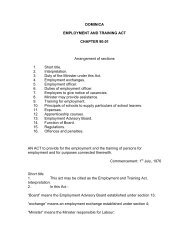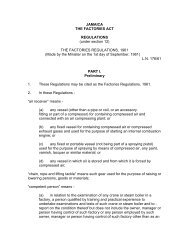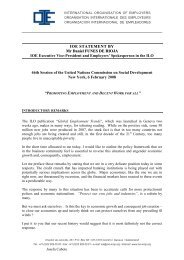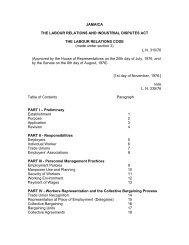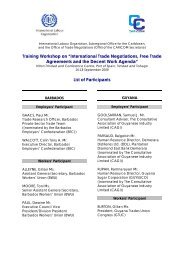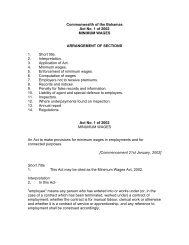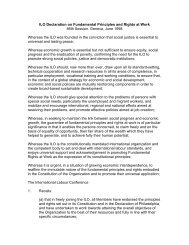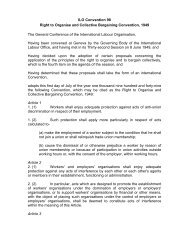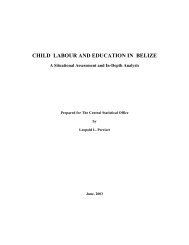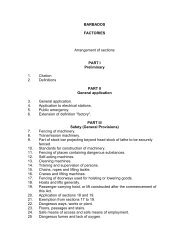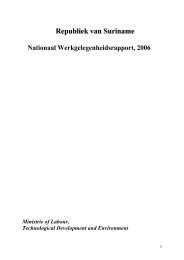ILO REPORT ON CHILD LABOUR IN BARBADOS - International ...
ILO REPORT ON CHILD LABOUR IN BARBADOS - International ...
ILO REPORT ON CHILD LABOUR IN BARBADOS - International ...
You also want an ePaper? Increase the reach of your titles
YUMPU automatically turns print PDFs into web optimized ePapers that Google loves.
Executive Summary<br />
___________________________________________________________________________________<br />
It’s Better in the Bahamas! …700 Islands….Beaches! Food Festivals! Casinos! Dolphins!<br />
Atlantis! The Bahamas Tourism advertisements appeal to royalty, romantics and retirees –<br />
indeed, anyone seeking relaxation. The islands of the Bahamas offer a variety of holidays for<br />
the over 4 million visitors who come each year. Proximity to the United States makes the<br />
country a favourite destination for its North American neighbours, and its proximity makes it<br />
even more attractive since ‘911.’ Tourism is the life-blood of the Bahamian economy and<br />
revenue from the sector contributed to its classification as a high human development country,<br />
ranking #33 on the Human Development Index in 2000. Annual per capita income was<br />
B$12,400 (1998) and the Bahamian dollar is on par with the US currency, although income<br />
and living standards vary widely. Prosperity and high employment attract migrant workers<br />
from neighbouring Francophone and Anglophone countries. Researching child labour amidst<br />
such abundance seemed a contradiction. Most Bahamians consulted associated child labour<br />
with sweat shops in far away countries.<br />
This Rapid Assessment on child labour in the Bahamas is part of the <strong>International</strong> Labour<br />
Organization’s <strong>International</strong> Programme on the Elimination of Child Labour (<strong>ILO</strong>/IPEC).<br />
<strong>ILO</strong> Convention No. 182 on the Worst Forms of Child Labour seeks to eradicate the<br />
involvement of children in slavery, prostitution and pornography, illicit activities and<br />
hazardous work.<br />
Using the <strong>ILO</strong>/UNICEF Rapid Assessment Methodology, a five-person research team<br />
conducted the field-work between 18-23 August 2002 to determine if there is child labour,<br />
and if so, to determine the magnitude, characteristics, causes and consequences. Socioeconomic<br />
data, policies, laws and conventions ratified were reviewed to determine the level<br />
of protection.<br />
Consistent with the decision of local stakeholders who met with the <strong>ILO</strong>/IPEC officer early in<br />
2002, various locations in Nassau, Paradise Island and Freeport, Grand Bahama, were studied.<br />
A convenience/snowball sampling method was used to identify key informants who were<br />
consulted through focus group discussions, interviews, semi-structured interviews and<br />
observations. Responses were coded to quantify the most common forms of work activity<br />
reported and content analysis of interviews and focus group discussions provided important<br />
qualitative data. Results were then triangulated to improve the validity of the findings.<br />
Orientation and debriefing workshops were held with the research team prior to and after the<br />
fieldwork and two Stakeholder workshops were held in Nassau and Freeport respectively. A<br />
seven-person Review Team appointed by stakeholders, met on October 4 to provide feedback<br />
on the draft report. In attendance were the Minister of Labour, Hon Vincent Peet, Permanent<br />
Secretary, Mrs. Thelma Beneby, Mr. Harcourt Brown, Ag. Director of Labour, Mr. Leslie<br />
Bowrin, the <strong>ILO</strong>/IPEC Officer from Trinidad and Tobago, two researchers, (Ms Denise<br />
Samuels and Mr. William Fielding) and the <strong>ILO</strong> Researcher.<br />
Rapid Assessments are quick and inexpensive, but because of their small sample size and<br />
non-random sampling method, the findings cannot be generalized. They however provide a<br />
‘picture’ of the child labour situation and a foundation for more in-depth research.<br />
4




